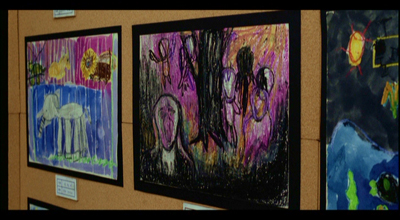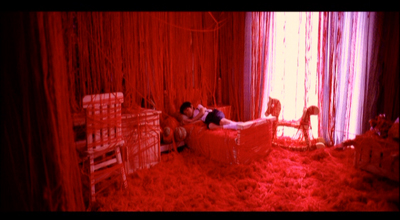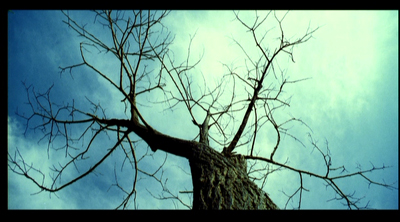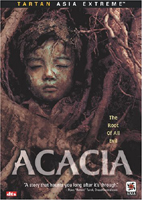MSRP: $24.99
RATED: R
RUNNING TIME: 102 Minutes
SPECIAL FEATURES:
• Feature Commentary w/ director and cast
• "Making-of" featurette
• Photo gallery
• Trailers
The Pitch
"The
second-best tree-based horror ever! Or, The Omen meets Rosemary’s Baby meets
Orson Scott Card’s Speaker for the Dead."
The Humans
Mun
Oh-bin, Kim Jin-geun, and Shim Hye-jin. None of them have done much that a
Western audience would recognize.
The Nutshell
A
childless couple decides to adopt. Who better to pick than the young boy who
doesn’t play with the other children and plagiarizes Edward Munch paintings
with his crayons and butcher paper? He’s perfect!
After the
couple bring young Jin-sung home, they try unsuccessfully to get him to open up
to them. The happy family can’t quite seem to make a connection with their new
child, so what do they do? They conceive on their own, finally. You’d expect
Jin-sung to feel a bit of jealousy over having his new position usurped by a
bundle of baby-flesh, but it manifests in his spending more and more time with
an acacia tree in the family’s back yard, and then in horrific dreams and
visions for the poor mother and father.
For
Pete’s sake, the kid copied "The Scream" at age five. They thought
this would end up well?

We’ve been wondering where all those paintings went.
The Lowdown
Unwanted
children are a common motif in horror cinema, from Damien to Rosemary’s little
demon seed. The themes that go along with the presence and influence of
children are generally rooted in responsibility, parental or otherwise. What
causes the parents to treat their children the way they do? What punishments do
the parents deserve? Acacia is no different, in the broad
sense, in that it is about two parents who don’t consider the feelings of their
adopted child when they toss his fate around as if he were an object of
gratification.
Deep
themes, yes, and pretentious when recounted by a lowly reviewer, but present
nonetheless. The problem is that they are fronted to the audience and make the
whole film feel didactic, kind of like a textbook with graphic illustrations. The
characters of the parents don’t serve much of a purpose other than performing
their tasks as story problems; y’know, "Hye-jin’s husband accuses her of trying
to kill him. Write a brief essay explaining why he is perfectly justified in
such an accusation."

Red room, red room— god, I’m sorry.
Something
that may drive potential viewers away from Acacia is the focus on yet another creepy child. We’ve all
gotten tired of complaints about creepy children, right after we grew tired of
the children themselves, but there’s good reason for the rolling of the eyes.
Creepy children are useful as an icon of a certain type of horror, but if you
build your film out of icons you end up with an audience who can’t suspend
their own disbelief. Acacia almost manages to avoid the
plague of creepy children by giving the child role a decent amount of
character. The young Munch-wannabe doesn’t just glare at people or meow like a
cat; he climbs trees, has a playful relationship with the girl next door, rides
his bike, and throws the occasional tantrum. When he’s coming over with an
obsession for the acacia tree out back, though, he topples over into soulless
piece of scenery, like Samara or that damn round-faced biter from Ju-On.
The other
horror elements are sort of hit or miss. The cinematography invests the acacia
tree with a portentous weight, but in moments in which the audience is supposed
to feel afraid, the tension is released with a plethora of jump scares. Jumps
don’t escalate tension — they’re like a valve that blows it off.
The
eventual conclusion is theme-focused, as you might expect, and wholly
appropriate to the story, while at the same time not leaving the audience with
much beyond a vague condemnation of irresponsibility. I like what Acacia
is trying to say in its cautionary language, but as a narrative film it falls a
little short in maintaining the audience’s fascination.

We will plant you!
The Package
A fine
5.1 DTS track is the crowning achievement of this disc. There’s a lot of
subtlety in the sound design (I’d have rather had it in the plot, but whatever)
and the rustling of leaves and the whistling of the wind do a nice job of
filling up the air in your home theater. There is also a Dolby Digital 5.1
surround track, with slightly less punch to it. The video is in anamorphic
2.35:1 and has a bit of trouble keeping excessive shadows opaque.
The
bonuses include a "making-of"
featurette, a not-very-lively commentary track with the director and selected
cast, a photo gallery, and trailers for other Tartan Asia Extreme releases.
6.4 out of 10

